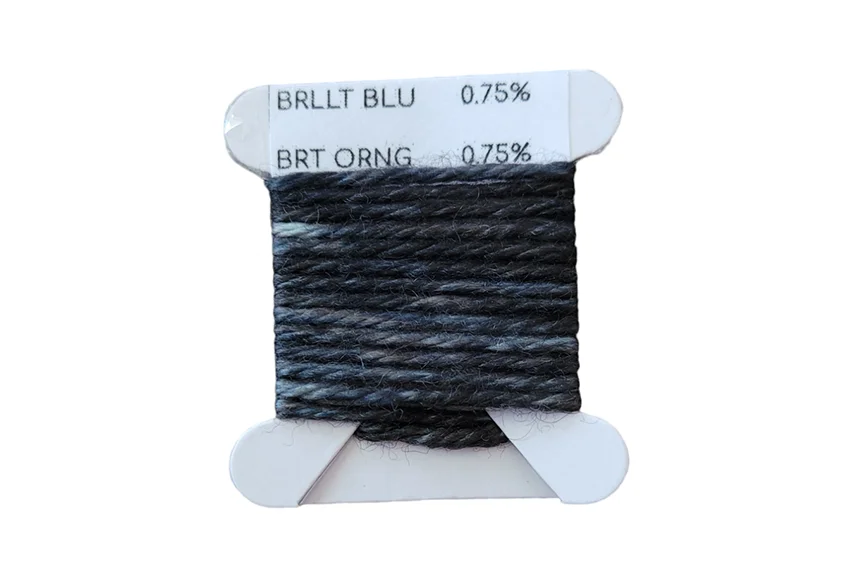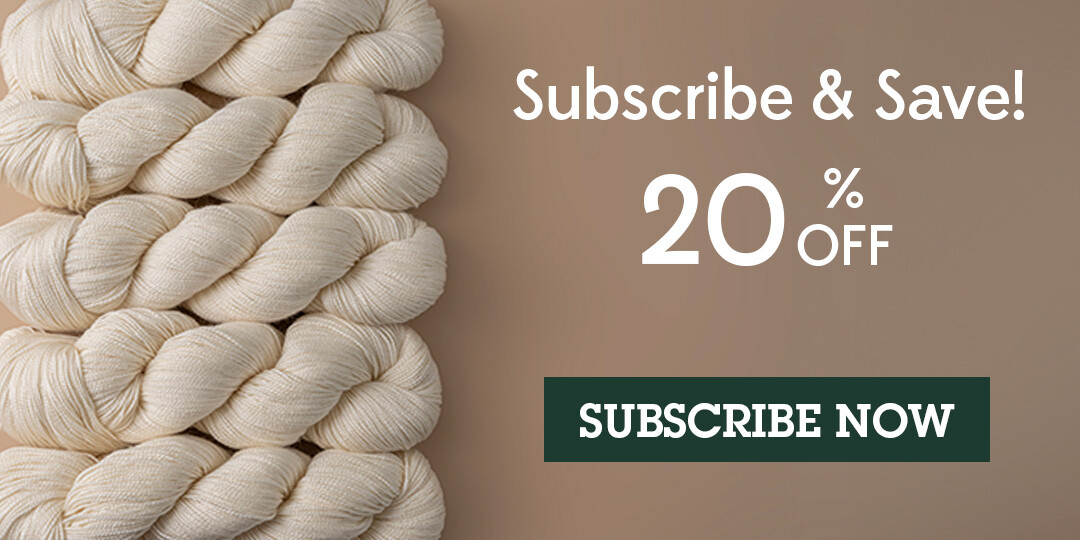Toning Your Colors Against Their Opposite: A study of complementary colors
Featuring: Knomad Marshmallow DK Select 20 Gram Minis; 100% 21.5 Micron Superwash Merino.
Our Goal: To learn about color theory by studying “complementary colors,” meaning colors opposite each other on the color wheel. Specifically:
- Hot Pink – Forest Green
- Orange – Purple
- Orange – Blue
- Red – Green
- Yellow – Violet
Abstract: What happens when we mix opposite colors at various intervals? At what point do the colors neutralize each other and turn gray or brown? And how can we measure these intervals precisely by dissolving dye in liquid and measuring dye stock in milliliters?
For those with time to read the finer details, let’s dive in! You will need:
- 55 Marshmallow DK Select mini skeins
- 1 ml syringe
- 10 ml syringe
- Gloves
- Respirator
- Double Burner Induction Cooktop
- 18 Glass Pint Jars
- Acid-Reactive Dye from Pro Chem Washfast acid in Lollipop Red, Juniper, Brilliant Blue, Bright Orange, Forest Green, Rhodamine Red, Orange Peel, Purple, Flavine Yellow, Brilliant Violet
- Laminated jar tags and string to tie them on with
- 8” deep, stainless-steel restaurant tray
- Citric Acid
- Gram Scale
- Synthrapol textile detergent
Fill an 8” deep tray with 2 gallons of warm water and 1 tsp of Synthrapol. Carefully untwist the minis and lay them across in a straight line so they can be easily picked out without tangling. Let the minis soak overnight so they’re thoroughly wet.
While the minis are soaking, measure out 10 jugs of water with 200ml in each, then mix 2 grams of dye each into their own jug for our stock. 10 different dyes, 10 jugs of individual dye stock. Since there’s 55 different skeins, weighing over 100 tiny fractions of a gram of dye would take days and be fairly inaccurate, since the powder dye scales are not super precise at .05 of a gram of dye.
Laminate a page with the following dye concentrations on it, hole punch and attach to your dye jar. This is how we will be keeping track of our percentages.
| Lollipop Red 1.5% |
Juniper 1.5% |
Brilliant Violet .75% | Flavine Yellow 1.5% | Brilliant Blue 1.5% | Bright Orange 1.5% | Forest Green 1.5% | Rhodamine Red 1% |
Orange Peel 1.5% | Purple 1.5% |
| 30ml | 0ml | 15ml | 0ml | 30ml | 0ml | 30ml | 0ml | 30ml | 0ml |
| 27ml | 3ml | 13.5ml | 3ml | 27ml | 3ml | 27ml | 2ml | 27ml | 3ml |
| 24ml | 6ml | 12ml | 6ml | 24ml | 6ml | 24ml | 4ml | 24ml | 6ml |
| 21ml | 9ml | 10.5ml | 9ml | 21ml | 9ml | 21ml | 6ml | 21ml | 9ml |
| 18ml | 12ml | 9ml | 12ml | 18ml | 12ml | 18ml | 8ml | 18ml | 12ml |
| 15ml | 15ml | 7.5ml | 15ml | 15ml | 15ml | 15ml | 10ml | 15ml | 15ml |
| 12ml | 18ml | 6ml | 18ml | 12ml | 18ml | 12ml | 12ml | 12ml | 18ml |
| 9ml | 21ml | 4.5ml | 21ml | 9ml | 21ml | 9ml | 14ml | 9ml | 21ml |
| 6ml | 24ml | 3ml | 24ml | 6ml | 24ml | 6ml | 16ml | 6ml | 24ml |
| 3ml | 27ml | 1.5ml | 27ml | 3ml | 27ml | 3ml | 18ml | 3ml | 27ml |
| 0ml | 30ml | 0ml | 30ml | 0ml | 30ml | 0ml | 20ml | 0ml | 30ml |
There are 2 “percentage points” I’m talking about here. The top percentages next to the dye color refer to what percentage of dry dye powder we’re using in proportion to the weight of the skein. For example, a 100 gram skein at 1.5% degree of strength is 1.5 grams of dye. For our 20 gram minis, 1.5% is .3 of a gram of dye. So the total amount of dye powder remains consistent among all 11 color values for each study.
The second percentage (broken down into milliliters of dye stock) is what percentage of Color A and what percentage of Color B are in each of the skeins. For example…
Lollipop Red and Juniper: We’re doing an 11-color study between the two, with each calculation being 2 parts adding up to 1.5% degree of strength. For easy math, let’s pretend that every skein is 100 grams instead of 20.
- Lollipop Red 100% (1.5 grams of dye)
- Lollipop Red 90% (1.35 grams of dye) – Juniper 10% (0.15 grams of dye)
- Lollipop Red 80% (1.2 grams of dye) – Juniper 20% (0.3 grams of dye)
And so on and so forth for each color until you get to 100% Juniper with 0% red in it. All the colors in between are 10% jumps between Lollipop Red and Juniper.
List of pure dyes from Pro Chem
I used this list of pure dyes from Pro Chem to create the color study. And I used Purple (a derivative dye that’s mixed with other colors) instead of Sangria because Sangria is way too red and too dark to use in the purple to orange study. Also feel like Forest Green is extremely “blue” and doesn’t behave like a primary, but since it’s on their list, it’s what I used.
You might be wondering why Brilliant Violet and Flavine Yellow or Forest Green and Rhodamine aren’t using the same percentage (1.5%) for each. It’s based on my 15 years of using these dyes and understanding how saturated they are. Yellow is the weakest color, meaning even the smallest amount of any other color will drown it out at 10% or more of a different color. I adjusted their strength accordingly so we saw a good progression of balanced color interplay.
Here’s the math on how to calculate the amount of dry dye powder into liquid painting stock:
- Skein Weight: 20 grams
- Desired Degree of Strength: 0.5% = 0.5/100 = 0.005
- (20 * 0.005) * 100ml = 0.1 * 100ml = 10ml
If the math isn’t “mathing” for you, just follow along with this dye chart:
| Degree of Strength | Amount of Dye Stock |
| 0.05% | 1ml |
| 0.10% | 2ml |
| 0.20% | 4ml |
| 0.30% | 6ml |
| 0.40% | 8ml |
| 0.50% | 10ml |
| 0.75% | 15ml |
| 1% | 20ml |
| 1.25% | 25ml |
| 1.50% | 30ml |
| 2% | 40ml |
Mix 1 tablespoon of citric acid into a 1000 ml jug and dissolve with hot water. Pour about 80 ml of this citric acid mix into each jar, then fill to ¾ of the way to the top with water. Put one skein into each jar and dunk it a few times to make sure there’s no crinkles in the skein that resist the dye and leave white patches.
Place 18 jars into an 8” deep stainless steel tray and fill until the jars are submerged ¾ of the way up in a water bath. Cover loosely with a lid and run at 300 degrees Fahrenheit for 45 minutes. Let cool to room temperature and rinse, making sure to tie the label from the jar onto the skein.
If you want to create a reference library of recipes like I have, wind the colors onto floss bobbins and print out the recipe to tape to the top.
Let’s admire our handiwork!
Here’s a closeup of each color progression:
Leftmost colors
Left-Middle Colors
Right-Middle Colors
Rightmost Colors
One color I absolutely love is this steely gunmetal gray – it’s the midpoint between brilliant blue and bright orange.
My favorite progression is the purple ←→ orange. Neither color overpowered the other and there’s some really pretty, unique colors on either side of the midpoint.
The flavine yellow and violet created some shaded greens that were surprising. This tells me that brilliant violet leans cool and blue.
The rhodamine red and forest green progression was a surprise, there’s no brown tones here at all! They lean very purple, which tells me there’s more blue in the forest green than the yellow.
The lollipop red to juniper created some gorgeous rusty browns. We can see that the green was quickly overpowered by the red.
I hope you enjoyed our color study and that you found some new favorite recipes to bring into your rotation!
Until next time,
Nic






































